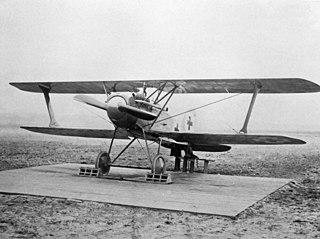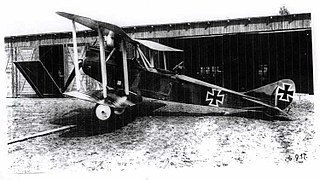Related Research Articles

The Albatros D.X was a German prototype single-seat fighter biplane developed in 1918 in parallel with the Albatros D.IX.

The LVG C.VI was a German two-seat reconnaissance and artillery spotting aircraft used during World War I.

The Rumpler C.IV was a German single-engine, two-seat reconnaissance biplane. It was a development of C.III with different tail surfaces and using a Mercedes D.IVa engine in place of the C.III's Benz Bz.IV. The Rumpler 6B 2 was a single-seat floatplane fighter variant with a 120 kW (160 hp) Mercedes D.III engine built for the Kaiserliche Marine.

The Hansa-Brandenburg CC was a single-seat German fighter flying boat of World War I. It was used by both the Kaiserliche Marine and the Austro-Hungarian Navy.

The Roland D.VI was a German fighter aircraft built at the end of World War I. It lost a fly-off to the Fokker D.VII, but production went ahead anyway as insurance against problems with the Fokker.

The Gotha WD.14, WD.20, and WD.22 were a family of biplane torpedo bomber floatplanes developed in Germany during World War I.

The Hansa Brandenburg W.27 and W.32 were prototype fighter floatplanes developed in parallel in Germany during World War I. They were developments of and intended replacements for the W.12 then in service and differed from each other principally in the choice of powerplant, the W.27 with a Benz Bz.IIIb and the W.32 with the same Mercedes D.III that the original W.12 used.

The LVG C.II was a 1910s German two-seat reconnaissance biplane designed at the Luft-Verkehrs-Gesellschaft for the Luftstreitkräfte.
The Aviatik D.III was a German prototype single-seater fighter plane from the First World War, designed by Aviatik. It became the basis for the Aviatik D.IV and Aviatik D.V. In November 1917, the plane was first flown, using a 195 hp Benz Bz IIIbo gearless engine. It was of similar design to the Aviatik D.II, and was armed with two LMG 08/15 machine guns. After several tests at Adlershof from February 9–12, 1918, the plane underwent modifications, as requested by the Idflieg. In April, a second prototype, powered by a Benz Bz IIIbm, although several D.III powered by the original IIIbo engine were already under production; however, none of them were ever completed.

The Otto C.I, also known as the Otto KD.15, was a German two-seat biplane reconnaissance and bomber aircraft of the First World War designed and produced by Otto Flugmaschinenfabrik. The C.I was a rare example of an aircraft flown by the Central Powers which had a pusher configuration.

The Luft-Fahrzeug-Gesellschaft (LFG) Roland D.VII was a German single seat, single engine biplane fighter aircraft built during World War I. Problems with its underdeveloped V-8 engine prevented its production.

The LVG G.III was a large, twin engine triplane bomber built in Germany near the end of World War I. Only one was completed.

The Zeppelin-Lindau CS.I was a German single-engined reconnaissance seaplane with a low-wing monoplane layout.
The Aviatik C.IX was a prototype German observation aircraft built by Aviatik in the final months of World War I.
The Aviatik C.VIII was a prototype German observation aircraft built by Aviatik in World War I.
The LVG C.VIII was a prototype reconnaissance aircraft built in Germany during World War I.
The LVG D.III was a German fighter plane built by LVG in World War I.
The LVG D.V was a prototype German biplane fighter built by LVG in World War I.
The LVG D.VI was a prototype German biplane fighter built by LVG in World War I.
The Märkische D.I was a prototype single-seat fighter biplane built in the last months of World War I.
References
- ↑ Rickard, J. (28 August 2014). "LVG D.IV". www.historyofwar.org. Retrieved 1 February 2019.
- ↑ Gray, Peter; Thetford, Owen (1970). German Aircraft of the First World War (2nd ed.). London: Putnam. p. 481. ISBN 0-370-00103-6.